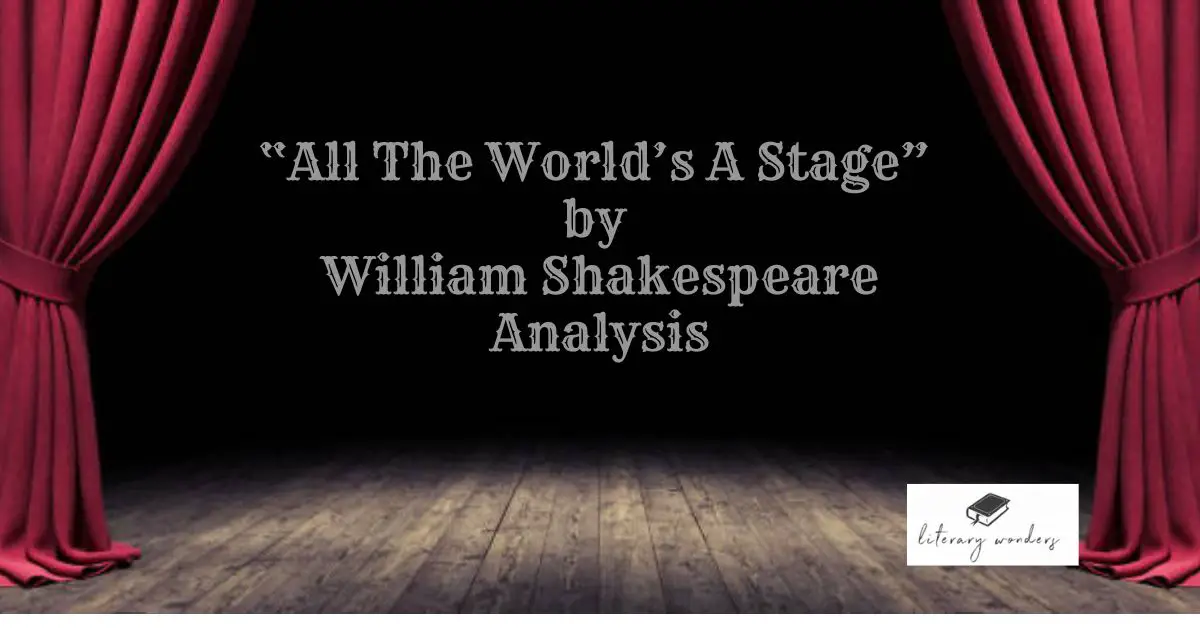Summary of “All the World’s A Stage”
“All the World’s A Stage” by William Shakespeare, an iconic historical writer, is a great composition. It is a part of his play, As You Like it, published in 1623. “As You like it” is a pastoral comedy that shows a monologue in which Jacques sheds light on the world’s nature and the people’s roles on earth. The writer brilliantly portrays the stages of life while comparing humans to stage actors. To him, each actor has to play specific roles simultaneously before they leave the stage.
In the bulk of this monologue, the speaker spends time going through each stage of our life. One comes to the world as an infant, goes through childhood and enters the best part of his life, youth. During youth, he becomes a lover, soldier, fighter and judge. He slowly loses control of his senses when youth passes and eventually becomes vulnerable and weak. Thus, the end takes us to the point where we once started being weak and fragile.
To read the full poem, Please click here.
Major Themes in “All the World’s A Stage”
The transience of life, love, childhood and man’ versus time are the significant themes crafted in the poem. This simple yet beautiful poem revolves around seven stages of man’s life. The writer shows how one begins life as an infant crying softly in the nurse’s arm. He slowly grows up and becomes a school-going boy, showing various tantrums. Ironically, time passes by, and the innocent schoolboy enters the most challenging phase of life, called a teenager. This age is depicted as an image of a dejected lover who composes love songs.
Slowly this phase passes, taking him to another stage called youth. Youth makes him go through various challenges and tests that later make him wiser in middle age. Later, just before the final stage comes old age which makes his mind weak and body dependent upon others. This is how one passes the time on earth before meeting his predestined end, death. Through this simple poem, the writer shows there is no escape from death. Every man on the earth has to go through the same transactional phases of life before death.
Analysis of Figurative Language Used in “All the World’s A Stage”
Figurative language includes various literary and poetic devices that the writers use to make their texts a treat for the readers. Their clever use makes their simple worlds deep, iconic and thought-provoking for the readers. William Shakespeare has used many poetic and literary devices in the poem whose analysis is as follows.
- Assonance: Assonance refers to repeated vowel sounds in any text. The writer has used this device in the poem, such as the sound of /e/ and /i/ and /o/ repeated in the following verse, “His youthful hose, well saved, a world too wide.”
- Allegory: Allegory uses description or narration in which actions, events, setting and characters represent specific abstractions or ideas. This allegoric poem speaks about the process life undergoes on earth.
- Blank Verse: It refers to a verse in which un-rhyming poetry is written in iambic pentameter. “All the World’s A Stage” is a blank verse poem.
- Consonance: Consonance refers to the use of repetitive consonant sounds in the same verse, such as /t/ and /s/ sounds are repeated in the following verse, “Sans teeth, sans eyes, sans taste, sans everything.”
- Imagery: Imagery makes simple texts appealing to the readers. The images used in the poem appeal to their five senses. Shakespeare skillfully used this device in the poem: “Sans teeth, sans eyes, sans taste, sans everything.”
- Irony: Irony is a literary device. It is employed in any text to add double meaning to the text. This is an ironic poem; the writer ironically comments on man’s life while dividing it into seven distinct stages.
- Metaphor: Metaphor uses implied or indirect comparisons of some objects in any text. The writer has used life and death as extended metaphors in the poem to show how our life hangs between the two.
- Symbolism: Symbolism means using signs and symbols to convey ideas, feelings and emotions. The poem shows symbols such as acting, life versus death, memory and transition.
- Stanza: Stanza is a poetic device in which verses are added to a text following specific patterns. The poem has twenty-eight lines with no stanza break.
- Simile: It is used to compare something to something else using words like “as” or “like.” The poem shows similes such as; “creeping like a snail”, and “like the pard.”
Conclusion
To sum up, “All the World’s A Stage” is a highly symbolic poem that takes us into a state where we can easily imagine the stages of life in just a blink of an eye. Furthermore, the writer has artistically inserted powerful images, diction and various other poetic elements to make us travel through these transitional phases of man’s life.#
Suggested Articles

